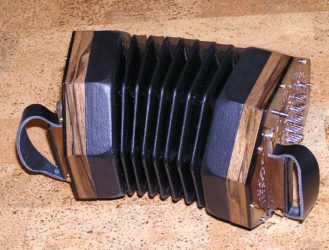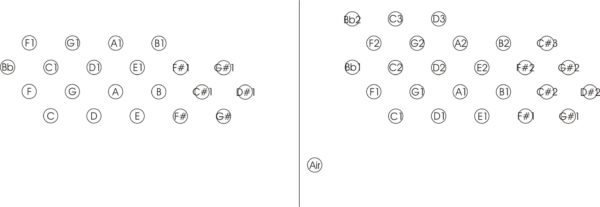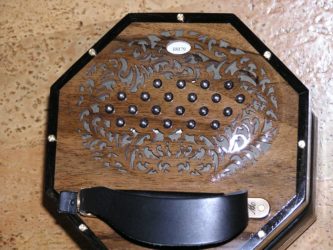Concertinas come in three main types — Anglo, English, and Duet. Anglos are the most common, and are the kind typically used to play Irish music, among other things. An anglo is bisonoric, meaning that, for a given depressed button, it produces a different note according to whether the bellows are pushed or pulled. English concertinas are the oldest type, invented by physicist Sir Charles Wheatstone at the early part of the nineteen century. They are unisonoric, so that depressing a button produces the same note on both push or pull of the bellows. The reeds are arranged in such a way that playing up or down the scale requires the alternate use of left and right hands.
 The least common type of concertina is the Duet, though it is arguably the easiest to play. There are several kinds of duets, characterized by different arrangements of buttons. All are unisonoric, and have the reeds arranged so that higher pitched notes are on the right side, lower pitched notes on the left. With this arrangement a musician can, for example, play a melody with the right hand and simultaneously play a bass accompaniment with the left hand. My concertina is a Hayden duet, named after Brian Hayden who in 1986 rediscovered an exceptionally clever button layout that allows changing keys in a particularly simple manner. (The layout was first discovered by Caspar Wicki in 1896.)
The least common type of concertina is the Duet, though it is arguably the easiest to play. There are several kinds of duets, characterized by different arrangements of buttons. All are unisonoric, and have the reeds arranged so that higher pitched notes are on the right side, lower pitched notes on the left. With this arrangement a musician can, for example, play a melody with the right hand and simultaneously play a bass accompaniment with the left hand. My concertina is a Hayden duet, named after Brian Hayden who in 1986 rediscovered an exceptionally clever button layout that allows changing keys in a particularly simple manner. (The layout was first discovered by Caspar Wicki in 1896.)
My instrument, a “W1” model made by Wakker Concertinas, is an example of a 46 button Hayden duet with true concertina reeds (not accordion reeds). The standard arrangement of buttons on a W1 is shown below:
 Starting with one of the c buttons, the notes of the C scale are reached by successively moving to the right through d to e, and then the next four notes (f, g, a, and b) are in line on the next row up. Using the same pattern, but starting with d, gives you the notes of the D scale: d, e, f#, g, a, b, c#. Likewise, the same pattern starting with g produces the notes of the G scale: g, a, b, c, d, e, f#. This clever arrangement of buttons means that a musician can shift the key of a tune, without changing the fingering, simply by shifting the hands appropriately.
Starting with one of the c buttons, the notes of the C scale are reached by successively moving to the right through d to e, and then the next four notes (f, g, a, and b) are in line on the next row up. Using the same pattern, but starting with d, gives you the notes of the D scale: d, e, f#, g, a, b, c#. Likewise, the same pattern starting with g produces the notes of the G scale: g, a, b, c, d, e, f#. This clever arrangement of buttons means that a musician can shift the key of a tune, without changing the fingering, simply by shifting the hands appropriately.
 My personal Wakker has walnut ends, and one thing peculiar to it. I discovered, by experimenting with a Hayden duet simulation on my iPad, that doing a mirror image of the button arrangement on the left (bass) side made it easier for me to play accompaniment to a given tune. So my W1 was custom made with a mirrored arrangement of the left side buttons, as you can see by comparing the button arrangement in the photo above with the left hand diagram shown earlier.
My personal Wakker has walnut ends, and one thing peculiar to it. I discovered, by experimenting with a Hayden duet simulation on my iPad, that doing a mirror image of the button arrangement on the left (bass) side made it easier for me to play accompaniment to a given tune. So my W1 was custom made with a mirrored arrangement of the left side buttons, as you can see by comparing the button arrangement in the photo above with the left hand diagram shown earlier.
I really enjoy playing tunes or accompaniment at jams by ear. In fact, at our Saturday jam i usually play the concertina, except when it’s my turn to sing. Then i fall back on my guitar. I also play it with Aspiration on some songs, which gives me a chance to perform breaks now and again.